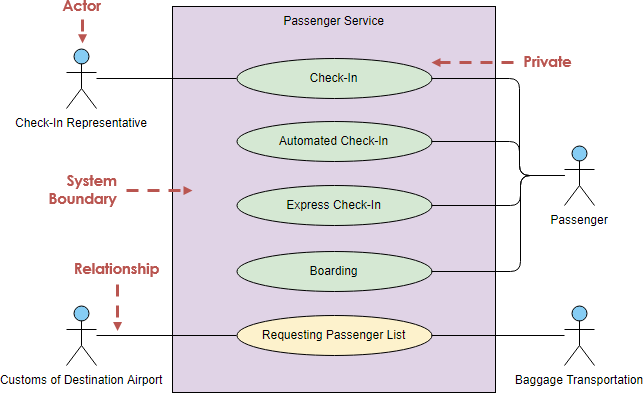موردهای استفاده، دیدگاههای کاربر از عملکردهای سیستم را مدلسازی میکنند، یعنی
- سیستم از نظر کاربر چه کاری انجام میدهد؛
- آنچه انجام میدهد برای کاربر ارزشمند است.
- مدل مورد استفاده راهی برای سازماندهی، ساختاردهی و مستندسازی حجم زیادی از اطلاعاتی که در طول جمعآوری نیازها به دست میآید، فراهم میکند؛
- این بخشی جداییناپذیر از مرحله توصیف نیازها در فرآیند توسعه است.
موردهای استفاده معمولاً گرافیکی هستند و نمودارهای مورد استفاده با توصیفهای متنی، از جمله توصیفهای مورد استفاده و شرکتکنندگان، و همچنین سناریوهای مرتبط با الگوهای مورد استفاده که روشهای مورد استفاده را ساده و شهودی میسازند، پشتیبانی میشوند و ابزارهای ایدهآلی برای بحث و روشنسازی درک توسعهدهندگان از نیازهای کاربر هستند.
پس از تکمیل و بررسی مدل مورد استفاده با کاربر، این مدل یک مجموعه ساختاری پایه از اطلاعات را تشکیل میدهد که سایر مدلهای سیستم بر اساس آن طراحی خواهند شد. مدل مورد استفاده همچنین برای آزمایش عملکردهای سیستم مفید است.
مدل مورد استفاده
مدل مورد استفاده شامل موارد زیر است:
- یک نمودار مورد استفاده،
- یک مجموعه توصیفهای مورد استفاده،
- یک مجموعه توصیفهای بازیگر
- یک مجموعه سناریو (توصیف شده توسط جریان رویدادها).
نمودار مورد استفاده از چهار مفهوم برای مدلسازی گرافیکی دامنه مشکل استفاده میکند: مورد استفاده، بازیگر، پیوند رابطه و مرز.
مورد استفاده: یک بیضی که با نام مورد استفاده علامتگذاری شده است. طبق عرف، ما هر نام مورد استفاده را با یک فعل شروع میکنیم تا نشان دهیم که مورد استفاده نمایانگر یک فرآیند است. بنابراین، ما از “نگهداری فهرست مشتری” به جای “فهرست مشتری” و “پردازش پرسش” به جای “پرسش” استفاده میکنیم.
یک بازیگر: یک شکل ساده چوبی با نام بازیگر. ما نام بازیگر را برای شناسایی آسان با حروف بزرگ مینویسیم (مثلاً کتابدار، دانشآموز).
بازیگران میتوانندافراد، سیستمهای دیگر، محرکهای زمانی یا محرکهای رویدادی. یک بازیگر نقشی را که توسط یک کاربر یا هر سیستم دیگری که با موضوع تعامل دارد، مشخص میکند. این ممکن است نقشهایی را که توسط کاربران انسانی، سختافزارهای خارجی یا سایر موضوعات ایفا میشود، نمایندگی کند.
رابطه مورد استفاده: یک خط که بازیگران را به موارد استفاده متصل میکند. این خط به ما نشان میدهد که کدام بازیگران با کدام موارد استفاده مرتبط هستند. این رابطه همچنین به عنوان ارتباط شناخته میشود.
مرزها: یک مستطیل که دور موارد استفاده کشیده شده است و آنها را از بازیگران جدا میکند تا دامنه سیستم را توصیف کند. مرزهای سیستم اختیاری هستند و اغلب نادیده گرفته میشوند.

هدف از نمودار مورد استفاده
مدلسازی مورد استفاده در مراحل مختلف فرآیند توسعه نرمافزار شیءگرا انجام میشود. سطح جزئیات و نوع اطلاعات نمایش داده شده در هر مرحله به هدف مدل بستگی دارد. اطلاعات مربوط به طراحی یا پیادهسازی دقیق سیستم در مراحل اولیه گنجانده نمیشود، زمانی که هدف اصلی ارتباط با کاربران است. بعداً، جزئیات فنی، مانند طراحی رابط کاربری، برای مرجع برنامهنویسان اضافه خواهد شد.
مورد استفاده در مقابل نمودار کلاس در توسعه سیستم
مهم است که درک کنیم که اگرچه مدل مورد استفاده نیازهای سیستم را تقسیم و ساختاردهی میکند، این ساختار به عنوان مبنایی برای ساخت سیستمهای نرمافزاری جدید استفاده نمیشود که در واقع توسط نمودارهای کلاس ارائه میشود.
مدل مورد استفاده سیستم را به عنوان نمای اصلی وظیفه کاربر میسازد.
نمودارهای کلاس سیستمها را با استفاده از مجموعهای از مؤلفههای نرمافزاری منطقی (اشیاء) میسازند.
نمودارهای UML
- UML چیست؟
- چرا مدلسازی UML؟
- مروری بر 14 نوع نمودار UML
- نمودار کلاس چیست؟
- نمودار مؤلفه چیست؟
- نمودار استقرار چیست؟
- نمودار شیء چیست؟
- نمودار بسته چیست؟
- نمودار ساختار ترکیبی چیست؟
- نمودار پروفایل چیست؟
- نمودار مورد استفاده چیست؟
- نمودار فعالیت چیست؟
- نمودار ماشین حالت چیست؟
- نمودار توالی چیست؟
- نمودار ارتباط چیست؟
- نمودار مرور تعامل چیست؟
- نمودار زمانبندی چیست؟
This post is also available in Deutsch, English, Español, Français, Bahasa Indonesia, 日本語, Polski, Portuguese, Ру́сский, Việt Nam, 简体中文 and 繁體中文.













